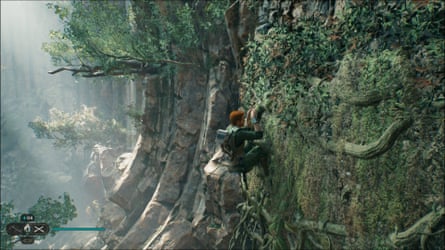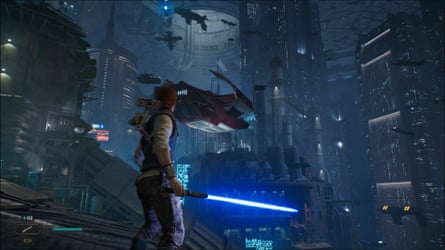Star Wars Jedi: Survivor’s opening sequence is spellbinding. Amid the sprawling megastructures of the city-planet Coruscant, a daring heist ensues. Having escaped the clutches of Darth Vader’s Imperial inquisition in the last game (Jedi: Fallen Order), fugitive Jedi Cal Kestis is now an agent for the Rebel Alliance, and his latest target is hidden inside a corrupt senator’s luxury space-yacht. What follows is a 90-minute thrill ride as Cal pursues the yacht through Coruscant’s tangled underbelly, slicing through stormtroopers and pirouetting across the city’s impossible architecture.
It’s everything you want from a Star Wars adventure and a blockbuster video game: visually spectacular, mechanically sophisticated and riotously entertaining. Respawn Entertainment’s first foray into Disney’s sci-fi universe had moments of vision, particularly in its beginning and ending, but sandwiched in the middle was an uneven mixture of Uncharted-style platforming and combat inspired by Dark Souls, set in environments that only occasionally lived up to the promise of its introduction. Jedi: Survivor is an enthralling follow-up and a huge improvement. Not only is it a masterclass in cinematic action, but its eclectic mixture of mechanics is also much more elegantly implemented. The result is the best Star Wars game in 20 years, as compelling in the hands as it is magnificent on the screen.
The difference reveals itself when Cal leaves Coruscant, travelling to a distant planet named Koboh to lie low and repair his damaged spaceship. Unlike Fallen Order’s second planet, a flat, confusing and uninspired backwater named Bogano, Koboh is a vast and striking open world that you’ll repeatedly revisit for the rest of the game, slowly unpicking the paths to its array of eye-catching landmarks. There are mountains to climb, ancient Jawa-scavenged ruins to explore, and Breath of the Wild-style Jedi temples to unearth. Most alluring of all is the vast, decaying dome of a crashed Lucrehulk battleship, from which spills a band of murderous raiders and their repurposed army of battle droids. The latter provides both satisfying lightsaber fodder and endearing comic relief as you travel across Koboh.
Unsurprisingly, combat is a focal point. You carve through a constant stream of imperial troops, battle droids and alien fauna. Fights will punish inattentive players, requiring deft taps of the parry and dodge buttons to keep Cal alive. But as Cal is an experienced Jedi, his array of established force powers makes the difficulty curve less severe. It also means you can pull and push stormtroopers around for fun from the start, shoving them off ledges and yanking them on to the point of your lightsaber. Later you can use several new lightsaber styles, with mixed success: combining a lightsaber with a blaster is enjoyably flexible, but the crossguard stance (inspired by Kylo Ren’s lightsaber) is too unwieldy to be useful.
Cal is acrobatic by default, able to run along walls, flip in midair, and scurry up sheer surfaces like a womp rat up a drainpipe. Survivor adds a grappling hook and a midair dash to these manoeuvres, resulting in incredibly kinetic movement that Respawn uses to build elaborate traversal challenges. Indeed, Survivor’s third-person platforming arguably outshines its combat, particularly in the second half of the game, when Cal spends more time with his feet off the ground than on it.

It helps that Survivor provides such dazzling spaces to navigate. While around half the game takes place on Koboh, you’ll also visit a gleaming High Republic facility on the planet’s shattered moon, and ancient Jedi temples located in the vast ochre deserts of Jedha. The latter is initially underwhelming; its platforming challenges are worryingly reminiscent of the weaker parts of Fallen Order, culminating in a lame sequence where you ride a spindly alien creature distractingly named a “spamel”. But Jedha redeems itself spectacularly on a return visit, kicking off a middle act that delivers a chain of marvellous extended set pieces, including a visit to that stupefyingly massive Lucrehulk.
The story Jedi: Survivor threads through these missions is similarly ambitious, if less consistent in its quality. Cal is a more believable protagonist in this game, with greater self-assurance and a grittier edge forged by his struggle against the Empire. The plot sees Cal pulled away from the rebellion by the promise of a new home safely beyond Imperial clutches, leading to a tale of obsession, betrayal and tragedy that threatens his fundamental decency. It’s sharply written and plays with intriguing ideas, including a sly inversion of a popular trope cherished by recent mainstream video games. But the story’s structure leads to certain arcs ending prematurely, while the characters lack the spark needed to fully land its bigger ideas.
after newsletter promotion
It might not quite match the narrative prowess of BioWare’s Knights of the Old Republic, but Jedi: Survivor has so much else going for it. Whether you’re tracking down optional bounty hunters, solving the puzzles in those Jedi temples, or searching Koboh’s many obscure thoroughfares for character upgrades, the game’s tactile controls and precisely balanced challenge make it consistently rewarding. Meanwhile, its biggest moments rival anything games like God of War or Elden Ring can throw at you. Be assured, this is the Star Wars game you’re looking for.

